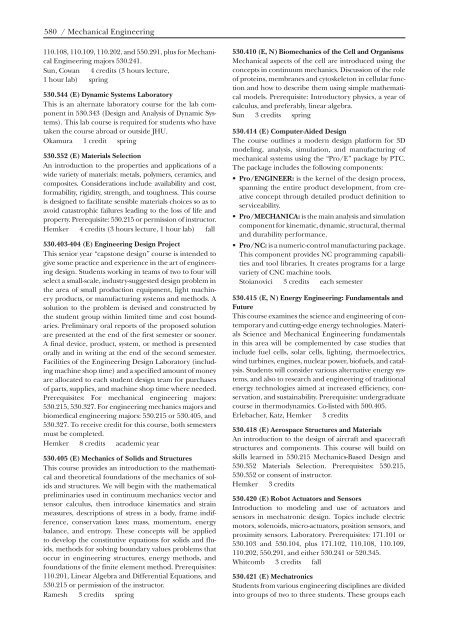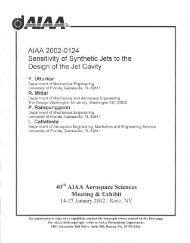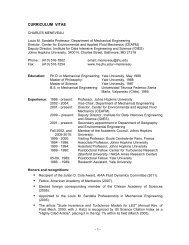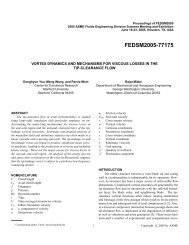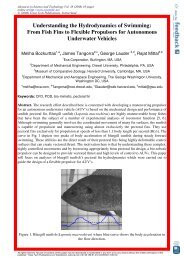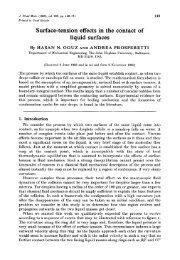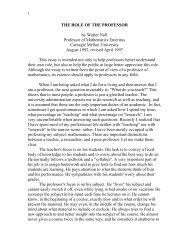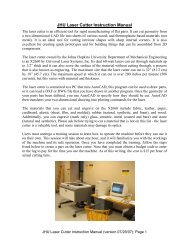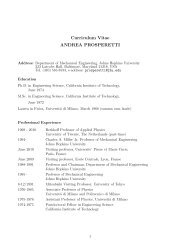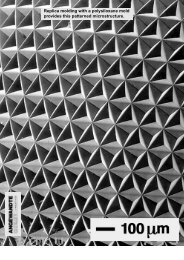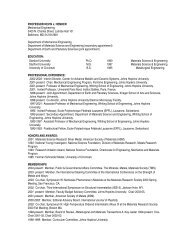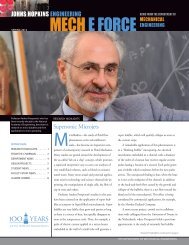Course Catalog - Mechanical Engineering - Johns Hopkins University
Course Catalog - Mechanical Engineering - Johns Hopkins University
Course Catalog - Mechanical Engineering - Johns Hopkins University
You also want an ePaper? Increase the reach of your titles
YUMPU automatically turns print PDFs into web optimized ePapers that Google loves.
580 / <strong>Mechanical</strong> <strong>Engineering</strong><br />
110.108, 110.109, 110.202, and 550.291, plus for <strong>Mechanical</strong><br />
<strong>Engineering</strong> majors 530.241.<br />
Sun, Cowan 4 credits (3 hours lecture,<br />
1 hour lab) spring<br />
530.344 (E) Dynamic Systems Laboratory<br />
This is an alternate laboratory course for the lab component<br />
in 530.343 (Design and Analysis of Dynamic Systems).<br />
This lab course is required for students who have<br />
taken the course abroad or outside JHU.<br />
Okamura 1 credit spring<br />
530.352 (E) Materials Selection<br />
An introduction to the properties and applications of a<br />
wide variety of materials: metals, polymers, ceramics, and<br />
composites. Considerations include availability and cost,<br />
formability, rigidity, strength, and toughness. This course<br />
is designed to facilitate sensible materials choices so as to<br />
avoid catastrophic failures leading to the loss of life and<br />
property. Prerequisite: 530.215 or permission of instructor.<br />
Hemker 4 credits (3 hours lecture, 1 hour lab) fall<br />
530.403-404 (E) <strong>Engineering</strong> Design Project<br />
This senior year “capstone design” course is intended to<br />
give some practice and experience in the art of engineering<br />
design. Students working in teams of two to four will<br />
select a small-scale, industry-suggested design problem in<br />
the area of small production equipment, light machinery<br />
products, or manufacturing systems and methods. A<br />
solution to the problem is devised and constructed by<br />
the student group within limited time and cost boundaries.<br />
Preliminary oral reports of the proposed solution<br />
are presented at the end of the first semester or sooner.<br />
A final device, product, system, or method is presented<br />
orally and in writing at the end of the second semester.<br />
Facilities of the <strong>Engineering</strong> Design Laboratory (including<br />
machine shop time) and a specified amount of money<br />
are allocated to each student design team for purchases<br />
of parts, supplies, and machine shop time where needed.<br />
Prerequisites: For mechanical engineering majors:<br />
530.215, 530.327. For engineering mechanics majors and<br />
biomedical engineering majors: 530.215 or 530.405, and<br />
530.327. To receive credit for this course, both semesters<br />
must be completed.<br />
Hemker 8 credits academic year<br />
530.405 (E) Mechanics of Solids and Structures<br />
This course provides an introduction to the mathematical<br />
and theoretical foundations of the mechanics of solids<br />
and structures. We will begin with the mathematical<br />
preliminaries used in continuum mechanics: vector and<br />
tensor calculus, then introduce kinematics and strain<br />
measures, descriptions of stress in a body, frame indifference,<br />
conservation laws: mass, momentum, energy<br />
balance, and entropy. These concepts will be applied<br />
to develop the constitutive equations for solids and fluids,<br />
methods for solving boundary values problems that<br />
occur in engineering structures, energy methods, and<br />
foundations of the finite element method. Prerequisites:<br />
110.201, Linear Algebra and Differential Equations, and<br />
530.215 or permission of the instructor.<br />
Ramesh 3 credits spring<br />
530.410 (E, N) Biomechanics of the Cell and Organisms<br />
<strong>Mechanical</strong> aspects of the cell are introduced using the<br />
concepts in continuum mechanics. Discussion of the role<br />
of proteins, membranes and cytoskeleton in cellular function<br />
and how to describe them using simple mathematical<br />
models. Prerequisite: Introductory physics, a year of<br />
calculus, and preferably, linear algebra.<br />
Sun 3 credits spring<br />
530.414 (E) Computer-Aided Design<br />
The course outlines a modern design platform for 3D<br />
modeling, analysis, simulation, and manufacturing of<br />
mechanical systems using the “Pro/E” package by PTC.<br />
The package includes the following components:<br />
• Pro/ENGINEER: is the kernel of the design process,<br />
spanning the entire product development, from creative<br />
concept through detailed product definition to<br />
serviceability.<br />
• Pro/MECHANICA: is the main analysis and simulation<br />
component for kinematic, dynamic, structural, thermal<br />
and durability performance.<br />
• Pro/NC: is a numeric-control manufacturing package.<br />
This component provides NC programming capabilities<br />
and tool libraries. It creates programs for a large<br />
variety of CNC machine tools.<br />
Stoianovici 3 credits each semester<br />
530.415 (E, N) Energy <strong>Engineering</strong>: Fundamentals and<br />
Future<br />
This course examines the science and engineering of contemporary<br />
and cutting-edge energy technologies. Materials<br />
Science and <strong>Mechanical</strong> <strong>Engineering</strong> fundamentals<br />
in this area will be complemented by case studies that<br />
include fuel cells, solar cells, lighting, thermoelectrics,<br />
wind turbines, engines, nuclear power, biofuels, and catalysis.<br />
Students will consider various alternative energy systems,<br />
and also to research and engineering of traditional<br />
energy technologies aimed at increased efficiency, conservation,<br />
and sustainability. Prerequisite: undergraduate<br />
course in thermodynamics. Co-listed with 500.405.<br />
Erlebacher, Katz, Hemker 3 credits<br />
530.418 (E) Aerospace Structures and Materials<br />
An introduction to the design of aircraft and spacecraft<br />
structures and components. This course will build on<br />
skills learned in 530.215 Mechanics-Based Design and<br />
530.352 Materials Selection. Prerequisites: 530.215,<br />
530.352 or consent of instructor.<br />
Hemker 3 credits<br />
530.420 (E) Robot Actuators and Sensors<br />
Introduction to modeling and use of actuators and<br />
sensors in mechatronic design. Topics include electric<br />
motors, solenoids, micro-actuators, position sensors, and<br />
proximity sensors. Laboratory. Prerequisites: 171.101 or<br />
530.103 and 530.104, plus 171.102, 110.108, 110.109,<br />
110.202, 550.291, and either 530.241 or 520.345.<br />
Whitcomb 3 credits fall<br />
530.421 (E) Mechatronics<br />
Students from various engineering disciplines are divided<br />
into groups of two to three students. These groups each


